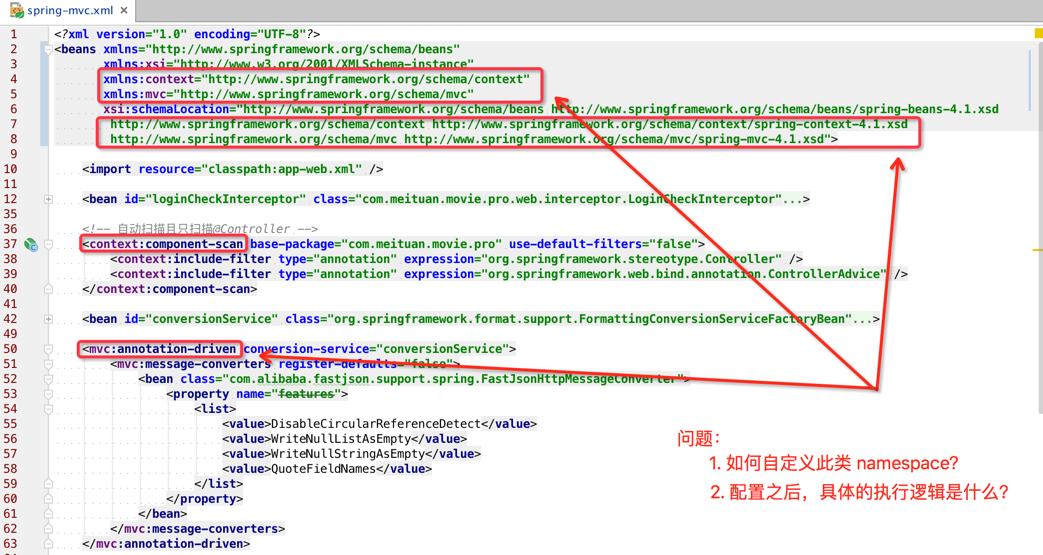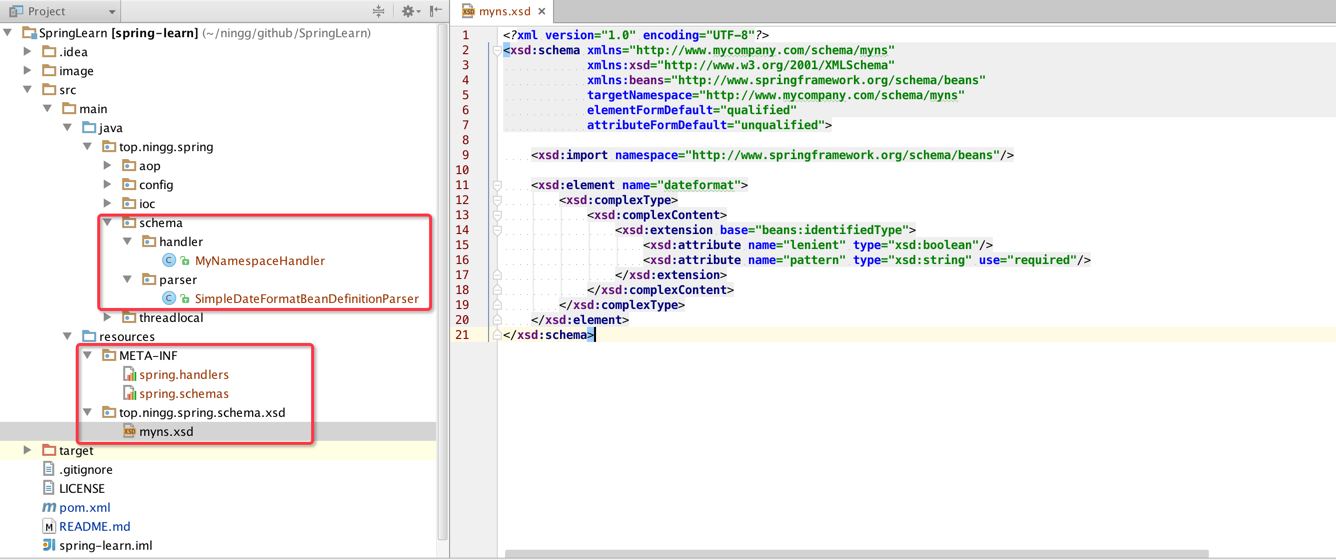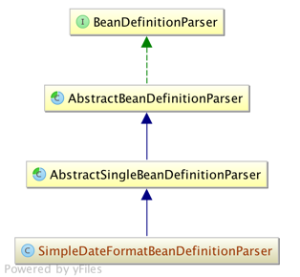Spring 源码:Namespace XML
2014-06-11
1. 目标
着重几个基本问题:
- Spring 配置文件中,不同namespace 背后的处理逻辑?
- 使用不同 namespace 的好处?
- 什么场景下,使用 namespace ?
- 如何自定义 namespace ?
描述的问题,形象一点就是:

2. 背景
Spring 中,定义和配置 Bean, 最直接的方式,使用下面的代码片段:
<beans xmlns="http://www.springframework.org/schema/beans"
xmlns:xsi="http://www.w3.org/2001/XMLSchema-instance"
xsi:schemaLocation="http://www.springframework.org/schema/beans http://www.springframework.org/schema/beans/spring-beans-4.1.xsd">
<!--传统定义 bean 的方式-->
<bean id="medis" class="com.meituan.cache.redisCluster.client.MedisBean">
<property name="authDao" ref="zkAuthDao" />
<property name="poolId" value="${cache_medis_pool}" />
<property name="authKey" value="${cache_medis_authKey}" />
</bean>
</beans>
针对一些 Bean,配置很复杂,这就需要调用方进行复杂的配置,很不方便,因此,Spring 2.0+ 后,支持用户自定义 schema 文件,来进行复杂 Bean 的自动配置。
使用自定义 schema 文件向 Spring IoC 中注入 Bean,需要涉及几个方面:
- 自定义 schema 文件
- 编写 Spring bean definition 解析器
- 将 Spring bean definition 解析器,集成到 Spring IoC 容器中
3. 自定义 schema 文件
自定义 schema 文件,实现复杂 bean 的自动配置,基本步骤:
- 编写 schema 文件
- 自定义 NamespaceHandler 的实现类
- 自定义 BeanDefinitionParser 的实现类
- 将上述 2 个自定义类,注册到 Spring 框架,使其生效
3.1. 极简实例
目标:定义一个 java.text.SimpleDateFormat 的 Bean。
预期结果:在 spring bean 配置文件中,使用如下配置,即可创建 java.text.SimpleDateFormat 的 Bean。
<myns:dateformat id="defaultDateFormat" pattern="yyyy-MM-dd HH:mm" lenient="true"/>
3.1.1. 整体目录结构

3.1.2. 编写 schema 文件
编写 schema 文件:myns.xsd
<?xml version="1.0" encoding="UTF-8"?>
<xsd:schema xmlns="http://www.mycompany.com/schema/myns"
xmlns:xsd="http://www.w3.org/2001/XMLSchema"
xmlns:beans="http://www.springframework.org/schema/beans"
targetNamespace="http://www.mycompany.com/schema/myns"
elementFormDefault="qualified"
attributeFormDefault="unqualified">
<xsd:import namespace="http://www.springframework.org/schema/beans"/>
<xsd:element name="dateformat">
<xsd:complexType>
<xsd:complexContent>
<xsd:extension base="beans:identifiedType">
<xsd:attribute name="lenient" type="xsd:boolean"/>
<xsd:attribute name="pattern" type="xsd:string" use="required"/>
</xsd:extension>
</xsd:complexContent>
</xsd:complexType>
</xsd:element>
</xsd:schema>
3.1.3. 编写 NamespaceHandler
NamespaceHandler 作用:解析 schema 文件中定义的元素,例如 解析<myns:dateformat /> 元素。
package top.ningg.spring.schema.handler;
import org.springframework.beans.factory.xml.NamespaceHandlerSupport;
import top.ningg.spring.schema.parser.SimpleDateFormatBeanDefinitionParser;
public class MyNamespaceHandler extends NamespaceHandlerSupport {
@Override
public void init() {
registerBeanDefinitionParser("dateformat", new SimpleDateFormatBeanDefinitionParser());
}
}
3.1.4. 编写 BeanDefinitionParser
BeanDefinitionParser 作用:解析指定的元素,例如,解析<myns:dateformat /> 元素的 BeanDefinitionParser 代码如下:
package top.ningg.spring.schema.parser;
import java.text.SimpleDateFormat;
import org.springframework.beans.factory.support.BeanDefinitionBuilder;
import org.springframework.beans.factory.xml.AbstractSingleBeanDefinitionParser;
import org.springframework.util.StringUtils;
import org.w3c.dom.Element;
public class SimpleDateFormatBeanDefinitionParser extends AbstractSingleBeanDefinitionParser {
@Override
protected Class getBeanClass(Element element) {
return SimpleDateFormat.class;
}
@Override
protected void doParse(Element element, BeanDefinitionBuilder bean) {
// this will never be null since the schema explicitly requires that a
// value be supplied
String pattern = element.getAttribute("pattern");
bean.addConstructorArgValue(pattern);
// this however is an optional property
String lenient = element.getAttribute("lenient");
if (StringUtils.hasText(lenient)) {
bean.addPropertyValue("lenient", Boolean.valueOf(lenient));
}
}
}
备注:补充说明,上述 SimpleDateFormatBeanDefinitionParser 实现了 2 个方法:getBeanClass 和 doParse,这是因为 Spring 中使用了大量的模板模式的缘故,而实际上 BeanDefinitionParser 只需要提供 parse() 方法即可。

3.1.5. 为 schema 文件绑定 NamespaceHandler
已经准备好了 schema 文件和 NamespaceHandler 处理类,如何让 Spring 识别呢?
Spring 规定:在 META-INF 文件夹下,新建 2 个特殊的配置文件,来注册 schema 文件和 NamespaceHandler 处理类。
META-INF/spring.schemas:namespace 的 xsd 文件,设置本地文件,避免 Spring 从网络获取 xsd 文件。META-INF/spring.handlers:为 namespace 绑定 NamespaceHandler
当前实例中,spring.shcemas 文件内容如下:
http\://www.mycompany.com/schema/myns/myns-1.0.xsd=top/ningg/spring/schema/xsd/myns.xsd
spring.handlers 文件内容如下:
http\://www.mycompany.com/schema/myns=top.ningg.spring.schema.handler.MyNamespaceHandler
其中:
- http://www.mycompany.com/schema/myns 为 xsd 文件中设定的 namespace
- http://www.mycompany.com/schema/myns/myns-1.0.xsd 为 spring 配置文件中,为上述 namespace 绑定的校验文件
3.1.6. 使用
上面完成的 namespace 的定义,如何实际使用呢?
- 发布自定义 namespace 的工程:在上述工程中,执行 mvn deploy,部署 jar 包
- 在 Spring 工程中:
- pom.xml 中,引入依赖的 jar 包
- 在 Spring 配置文件中,引入 namespace
本例中,在 Spring 配置文件中,引入 namespace 如下:
<?xml version="1.0" encoding="UTF-8"?>
<beans xmlns="http://www.springframework.org/schema/beans"
xmlns:xsi="http://www.w3.org/2001/XMLSchema-instance"
xmlns:myns="http://www.mycompany.com/schema/myns"
xsi:schemaLocation="
http://www.springframework.org/schema/beans http://www.springframework.org/schema/beans/spring-beans.xsd
http://www.mycompany.com/schema/myns http://www.mycompany.com/schema/myns/myns-1.0.xsd">
<!-- as a top-level bean -->
<myns:dateformat id="defaultDateFormat" pattern="yyyy-MM-dd HH:mm" lenient="true"/>
</beans>
特别说明:此处 namespace 和 xsd 文件 url 路径,已经要跟 spring.schemas 和 spring.handlers 文件中的配置保持一致,完全一致。
4. 特别说明
上面是针对 Spring 中完整 bean 的定义,实际上,也可以针对先有 bean 的属性进行定义。
5. 参考来源
6. 附录
思考:
- 上述 schema 文件执行的时间?在 bean 生命周期中的位置?context 初始化的时候?
- Bean 生命周期的切入点,实践分析时,参考调度框架 Crane 的实现
原文地址:https://ningg.top/spring-framework-series-xml-namespace/